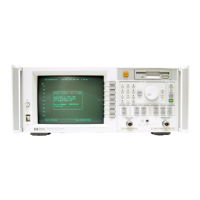Calibrating for Increased Measurement
Accuracy
Choose an Appropriate Calibration Method
To
Perform
a
Reflection
Calibration
A reflection calibration removes systematic directivity, source match and
frequency response errors. This type of calibration is also for narrowband
measurements only.
For an example of performing a reflection calibration for a transmission
measurement refer to “Measuring Reflection Response” in Chapter 3.
Otherwise, follow these general steps when performing a transmission
calibration:
1. Setup the analyzer for your measurement:
l select
(MEAS1)
or @EXE)
R&l.e~%itm
l enter operating parameters other than the default
2. Press
m,
and then one of the following softkeys:
Restoring the default calibration recalls error correction arrays that the
network analyzer previously generated by an adjustment test and stored
permanently in memory. This calibration was performed at the factory or
during servicing using full band (entire frequency span) and 401 frequency
points. It is quick and convenient but not as accurate at narrow frequency
spans. This calibration is also known as the default calibration.
A one-port calibration prompts you to connect three measurement standards:
an open, a short, and a load. The analyzer measures each standard across
the frequency band you have defined, using the number of points you have
deEned.
The measurements of these standards are used to remove systematic
errors caused by directivity, source match, and frequency response.
Reflection Calibration
Widening the frequency span after performing this calibration will invalidate
Interpolation
it, and restore the default calibration. You may narrow the span and the
analyzer will interpolate correction for the narrower span.
6-13
I-
深圳市盛腾仪器仪表有限公司 Tel:0755-83589391 Fax:0755-83539691 Website: www.Sengt.com

